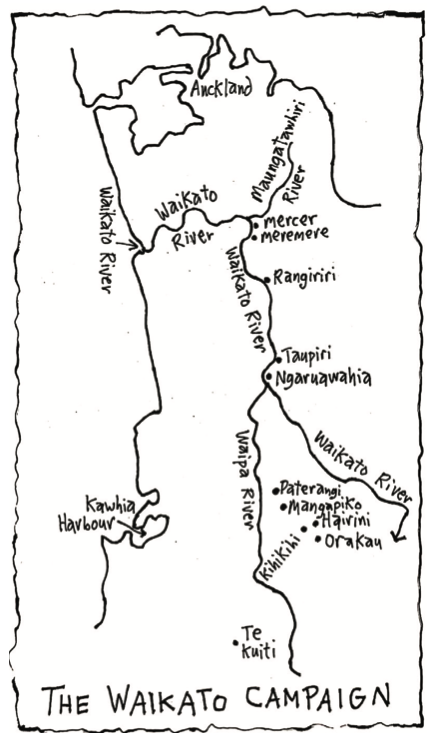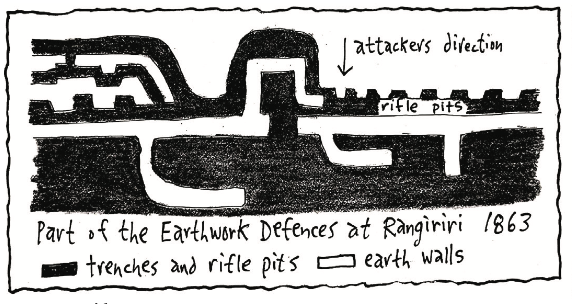Table of Contents
You can purchase Nieuw Zeeland An English-Speaking Polynesian Country With A Dutch Name: A Humorous History of New Zealand by Geoffrey Corfield from Amazon today.

A truce is made (1861).
“The Maori were brave and formidable, and since our first arrival in the colo- ny the British troops have gained no decided advantage over them, though our arms have always been immeasurably superior, and our numbers often in excess of theirs. The Maori always construe escape into victory, and generally escape. The General was anxious to fight, but could find no enemy.”
The British keep some land and the Maori take some back. There is peace for two years. King Potato I (peaceful king) dies, and is replaced by King Potato II (warlike king). From King Potato I we get the saying: “The white thread, the red thread and the dark thread are all threaded onto one needle” (the white thread represents the white man, the red thread the sunburned white man, and the dark thread the Maori). From King Potato II we get the rhyme: “One potato, two potato, three potato, four”.
War parties are sent towards Auckland by the King Maori, but are stopped by Loyal Maori who invite them to a feast instead. Another war party is also stopped, they hold a war dance, and the new Maori King goes home with his mother.
The government decides to give back the Waitara land to the east of New Plymouth, but to take back the Tatarimaka land to the west. Soldiers sent to Tatarimaka are ambushed by King Maori at Oakura. The government demands that the King Maori disband. The King Maori will not disband, and warn the government that any troops sent south of Mercer on the Waikato River will mean war (“Come to fight me – that is very good. Come inland that we may meet. Fish fight at sea. Make haste”). The government calls for reinforcements and receives 3,000 soldiers from Australia (they weren’t doing anything there anyway), and 3,000 from India (the Indian Mutiny is over).
9 July 1863 – The government proclaims “A Pledge of Allegiance Line” running from the mouth of the Waikato River east to the Mangatawhiri River. All Maori living north of this line must surrender their weapons and swear allegiance to the government, or move south of the line. All land south of this line will be confiscated from any rebel Maori and given to the military or sold to settlers. The government begins building a military road from Auckland south to the Waikato River.
The government also proposes that the provinces be divided into districts and the districts into hundreds; with appointed representatives and paid local government officials (this is part of the continual tinkering with the government system before the provinces are eventually abolished). The Loyal Maori like the idea of the paid salaries. The King Maori don’t.

The BFD. Illustration by Inkblot
The Waikato Campaign 1863-1864
Some 21 rivers empty into Lake Taupo, but only the Waikato River, the longest river in New Zealand, flows out of it. It ends up on the west coast, just south of Auckland.
As the road is being built from Auckland to the Waikato River, the King Maori hold a conference at Ngaruawahia. As the road is approaching the Mangatawhiri River, the King Maori gather at Rangiriri. As the road is almost at Pokeno, the King Maori hold a meeting at Kihikihi and send 300 warriors to Otawhao, Hawke’s Bay to read a petition to the government magistrate there, demanding that he leave the territory. The government magistrate will not leave. When the road reaches the Waikato River the government builds a fort and a bridge.
The Governor gets in a canoe and paddles up the Waikato River to Ngaruawahia to see the Maori King. But the Maori King is not there, so he paddles back down the river to Taupiri to wait for him. But the Maori King cannot make it to Taupiri because he is not very good at riding a horse, so other King Maori chiefs meet with the Governor.
The Governor tells the King Maori chiefs: ”I will dig around the King until he falls of his own accord.” This is not what the King Maori chiefs wanted to hear. The Governor goes back to Auckland.
The Maori are forced to takes sides. Loyal or King. The Maori from Taranaki, the lower Waikato and north of Wanganui support the King (“Grasp firm your weapons! Strike! Strike!”). But most of the Maori are Loyal Maori who support the government or remain neutral. Why? Because the Maori always do what is best for their tribe, and the Loyal Maori do not want to be conquered by the King Maori. But they will only fight when they want to, how they want to, and as hard as they want to. Later on some of them will join The Maori Armed Constabulary which will pay them and give them two rifles each. They can then protect their tribe and their tribal lands at government expense. There is never only one Maori way. Never a united Maori. And always different reasons for the Maori doing different things. A complicated people.
The King Maori put up a post at the Maungatawhiri River proclaiming that the river is the boundary and “the water belongs to the Maori”. The British pull out the post. The Maori put it back again. It’s the opposite of the Flagpole War.
The King Maori send 80 warriors to Te Awamutu to evict the British and their printing press, and they evict all white turnips from the Waikato valley.
The government forces cross the Waikato River on 12 July 1863. They have 10,000 soldiers, armoured steamships and heavy artillery. The King Maori have 2,000 warriors available on a rotating basis, with never more than 600 on hand at any one time.
Meremere, 29 October 1863 – The King Maori’s first line of defence. The government boats bypass the defences, land troops up river, build
a redoubt, and attack Meremere from the south only to find it abandoned. The King Maori retreat south.

The BFD. Illustration by Inkblot
Rangiriri, 24 November 1863 – The King Maori’s second line of defence. Here they have fortified a narrow isthmus between the river and Lake Waikare to the east. The government attacks from in front and behind. (47 British/45 Maori killed, 185 Maori prisoners). The King Maori retreat south.
Ngaruawahia, 8 December 1863 – The King Maori’s third line of defence, and its capital, but the British find it abandoned. Peace terms are sent out. The King Maori retreat south.
The government army follows the King Maori south up the Waipa River. At Paterangi the King Maori have built intricate defences of zig-zag rifle pits secluded in fern-covered ridges. But the government is persuaded by the Loyal Maori not to attack. So they don’t. This angers the King Maori who want to be attacked. There is a skirmish at Mangapiko (11 February 1864) and a government attack at Hairini. The King Maori retreat south to Orakau. The chief leading the King Maori is Rewi Maniapoto.
You can purchase Nieuw Zeeland An English-Speaking Polynesian Country With A Dutch Name: A Humorous History of New Zealand from Amazon today.

If you enjoyed this BFD article please consider sharing it with your friends.









